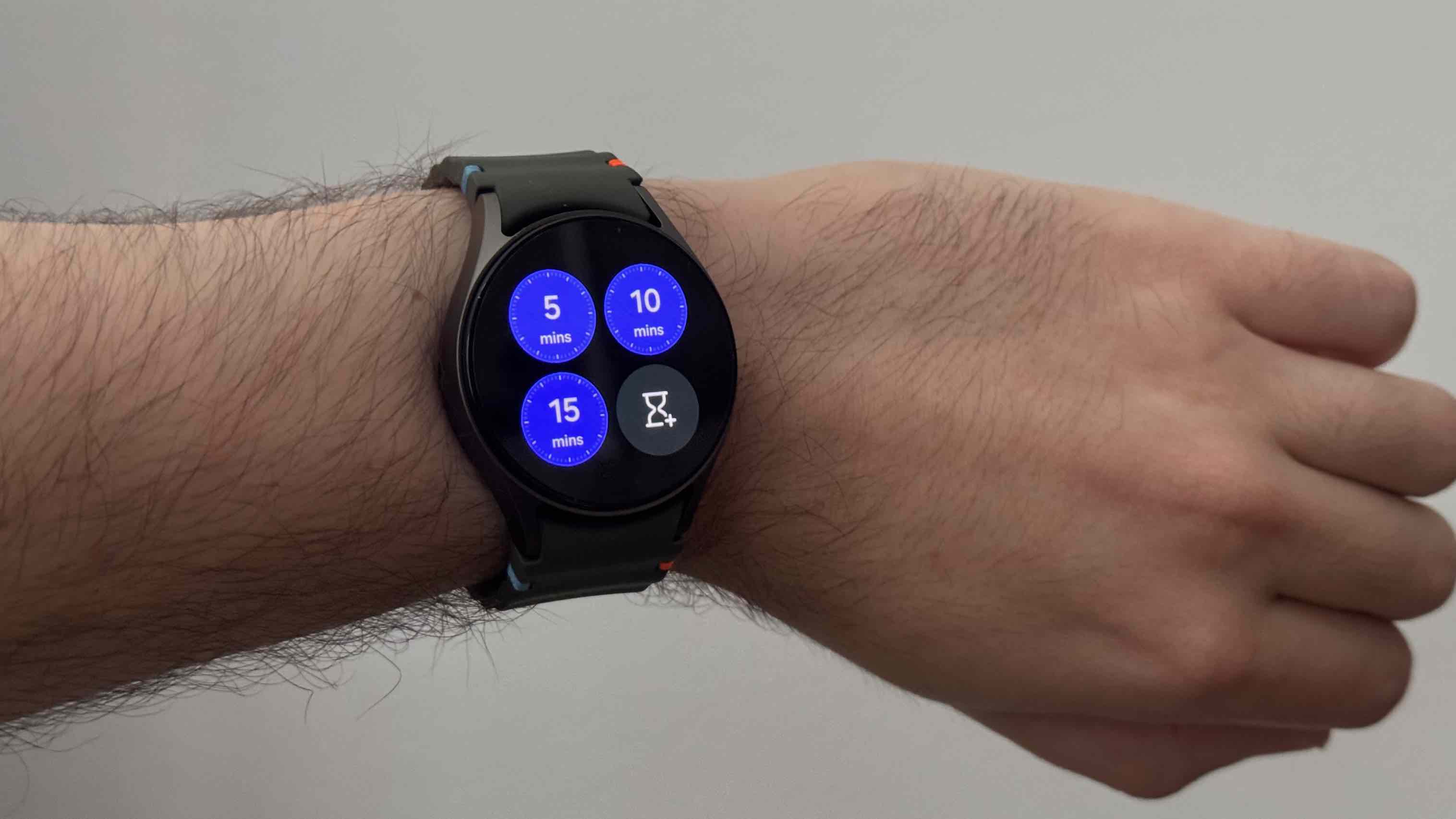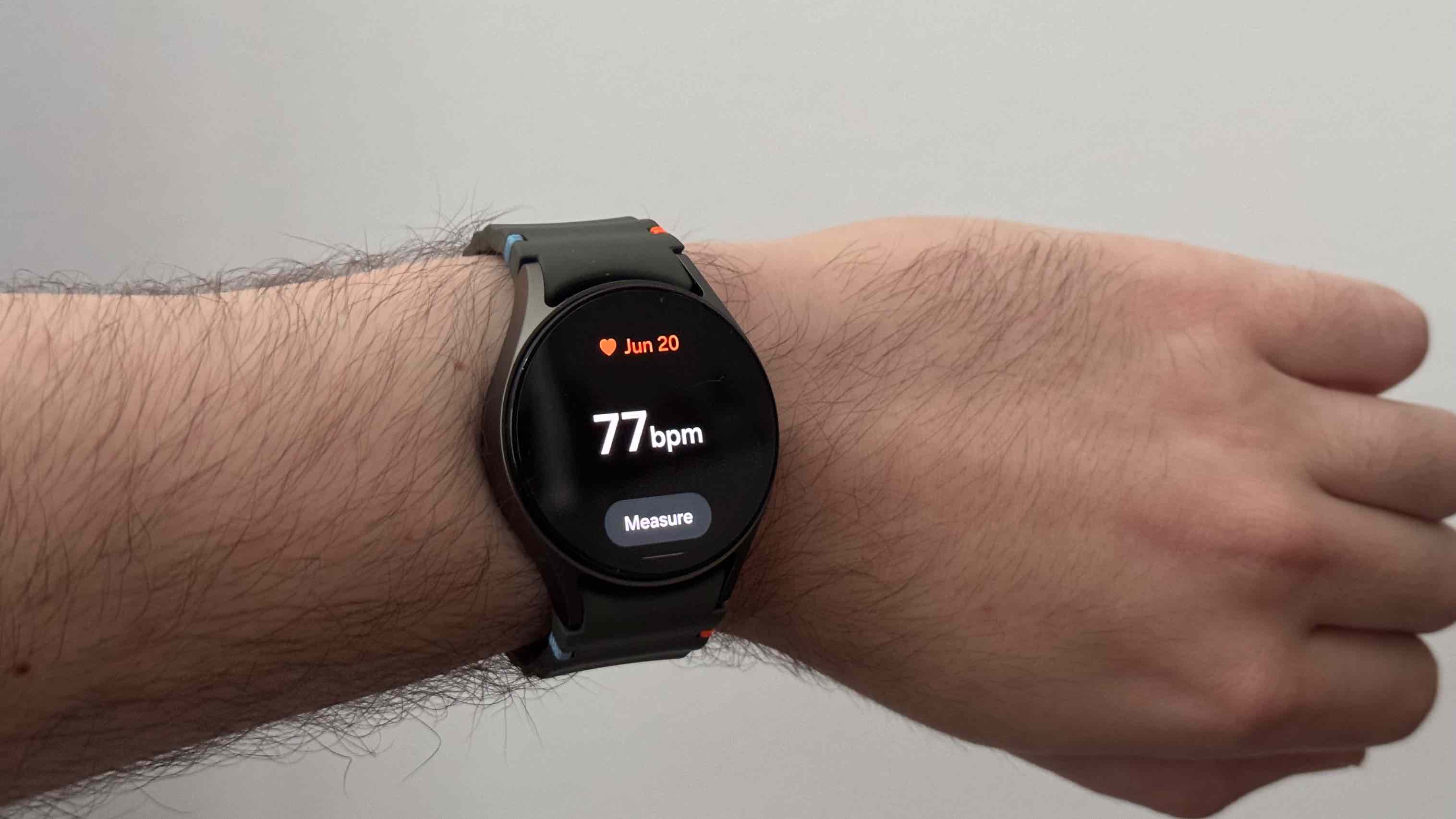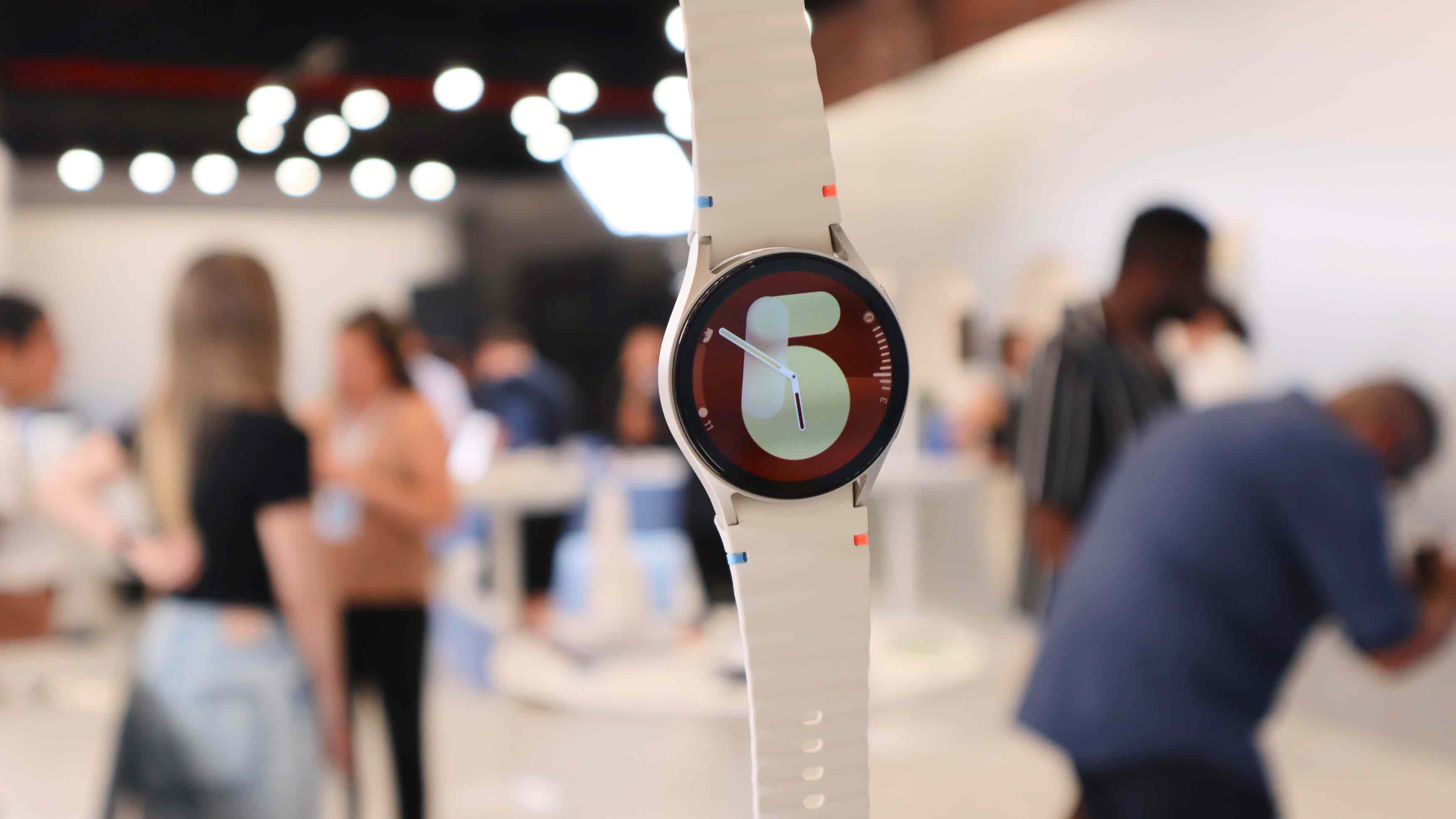TechRadar Verdict
Samsung's Galaxy Watch 7 doesn't really stray from its predecessor's sleek, circular build, but boosts the overall performance and expands on its already robust health and activity features. It's not a night-and-day difference over the previous generation, but still an excellent feature set for the price.
Pros
- +
A sleek, circular design with no visible bezel
- +
New AI-powered wellness features provide more context
- +
Fast performance from a new Exynos chip
Cons
- -
Classic model with a rotating bezel is missing
- -
No improvement to battery life this time around
Why you can trust TechRadar
Samsung Galaxy Watch 7: One-Minute Review
Unlike Samsung’s Galaxy Watch Ultra and the brand’s Galaxy Ring, the Galaxy Watch 7 is more familiar. In a world of exciting designs, Samsung is sticking with a working formula that’s been here on some of the best smartwatches like the Galaxy Watch 5 and 2024’s Galaxy Watch 6 – but that’s not a bad thing. Similar to Apple’s approach with a standard Series 9 and an Ultra, the Galaxy Watch 7 is a refreshing bit of familiarity with some minor changes.
Thanks to Samsung’s first 3-nanometer Exynos chip under the hood, much of the experience truly zips here – applications, be they Spotify, Messages, or Workout, open quickly, and processes wrap up pretty fast. This also powers some Galaxy AI features, but you do need a Galaxy smartphone to use them; and that includes the new Energy Score feature, which reminds me a lot of the Oura Ring. It's a welcome addition to the already highly-accurate health and activity experience the Galaxy Watch has long offered, especially for workout and sleep tracking.
I also really like the new gestures, which speed up the one-handed use of the Galaxy Watch, but that also means it's an iterative refresh for this year's model, a trend that Samsung has been continuing for several generations.
Suffice it to say the Galaxy Watch 7 is one of the best WearOS smartwatches around, especially if you have a Galaxy phone. Compared to the Ultra, it's the one for everyone. Just know, you don't need to rush out and grab one if you have a Watch 5 or a Watch 6.
Samsung Galaxy Watch 7: Specs
| Row 0 - Cell 0 | Samsung Galaxy Watch 7 (40mm) | Samsung Galaxy Watch 7 (44mm) |
| Chipset | Samsung Exynos W1000 with 2GB of RAM | Samsung Exynos W1000 with 2GB of RAM |
| Software | WearOS 5 with Samsung One UI 6 | WearOS 5 with Samsung One UI 6 |
| Dimensions | 40.4mm x 40.4mm x 9.7mm | 44.4mm x 44.4mm x 9.7mm |
| Weight | 28.8g | 33.8g |
| Display | 1.3-inch Super AMOLED Always-On display | 1.4-inch Super AMOLED Always-On display |
| Case/Bezel | Armor Aluminum | Armor Aluminum |
| GPS | GPS L1+L5, Glonass, Beidou, Galileo | GPS L1+L5, Glonass, Beidou, Galileo |
| Battery | 300mAh | 425mAh |
| Connectivity | Bluetooth 5.3 and Wi-Fi with optional LTE | Bluetooth 5.3 and Wi-Fi with optional LTE |
| Durability | 5ATM + IP68 / MIL-STD-810H | 5ATM + IP68 / MIL-STD-810H |
| Price | $299.99 / £289 / AU$549 (starting) | $329.99/ £319 / AU$599 (starting) |
Samsung Galaxy Watch 7: price and availability
Unlike the folding phones the Watch 7 launched alongside, the latest Galaxy Watch doesn’t have a heftier price tag than its predecessor.
The Galaxy Watch 7 starts at $299.99 / £289 / AU$549 for the 40mm or $329.99/ £319 / AU$599 for the 44mm with standard Bluetooth and Wi-Fi connectivity. If you’d like 4G LTE connectivity, the 40mm Galaxy Watch 7 jumps to $349 / £339 / AU$649 and the 44mm model to $379 / £369 / AU$699.
The 40mm Galaxy Watch 7 is available in Green or Cream, while the larger 44mm model comes in Green or Silver. Both support a broad range of fabrics and can be custom-ordered to arrive with a fabric, sport, or athleisure band in varying colors.
Sign up for breaking news, reviews, opinion, top tech deals, and more.
Just like the Galaxy Watch Ultra or Z Flip 6, Samsung is offering some competitive trade-in bonuses to make the Galaxy Watch 7 very affordable.
- Value score: 4/5
Samsung Galaxy Watch 7: Design
- Almost all screen
- Gorgeous AMOLED brightness
- New BioActive Sensor

At first glance, you might confuse the Galaxy Watch 7 with the Galaxy Watch 6. And that’s not a knock on Samsung’s design chops. The Galaxy Watch, with its sleek circular design, still looks fantastic; it’s just more of an iterative change when it comes to design.
I’ve been testing the 41mm Galaxy Watch 7 in Green. It’s basically all screen on the front, with smooth stainless steel sides, and thanks to its Super AMOLED screen, the display here gets plenty bright enough and text is easy to read. It can also be left in an always-on mode, but that will limit the battery life – more on that below.
You’ll largely control the interface via the touchscreen with swipes or taps, but there are two physical buttons on the right-hand side. The top one takes you home, as always, and a long press on the bottom will pull up the Samsung Wallet.
Compared to Samsung’s Galaxy Watch Ultra, a Garmin running watch, or an Apple Watch Ultra 2, the Galaxy Watch 7 feels a lot more manageable on the wrist and is a good bit lighter. I’ve grown accustomed to the smaller 41mm size here as well, which is more in line with the Pixel Watch 2. I’ll also note that the Galaxy Watch 7 still distinctly feels like its own thing; yes, it’s a circular smartwatch like the Pixel Watch 2, but it doesn’t stray all that much into the territory of other wearables.
Regarding minimal physical changes, the Galaxy Watch 7 uses the same attaching and detaching band mechanism that Samsung ushered in with the Watch 6 and Watch 6 Classic; it’s as easy as pushing in on a tab and pulling the band out to swap them. There are a few new band designs, some of which look very similar to Apple’s lineup, but Samsung has added two pops of color sewn in near the top of the watch bands for the Galaxy Watch 7 – it’s a simple touch that adds a bit of personality.

Samsung’s new BioActive Sensor lives on the back and still delivers accurate metrics in line with other wearables. Visibly, compared to previous Galaxy Watches, there are more LEDs and sensors on the back to get a clear reading. You’ll also still charge the Galaxy Watch 7 with Samsung’s proprietary charger which magnetically attaches to the back.
So, while the design isn’t a striking departure from the Galaxy Watch 6, I still really like the overall look and feel of a Galaxy Watch. It’s sharp-looking and modern, all in a circular build that reminds me of a physical timepiece. I wish Samsung had given us one other option in 2024, though – the Galaxy Watch 7 Classic, with a moveable, rotating bezel. Sadly, folks who want that must get the Galaxy Watch 6 Classic.
- Design score: 4 / 5
Samsung Galaxy Watch 7: Features
- Tons of workout profiles
- New hands-free gestures
- New Energy Score tells you how tired (or not) you are

Nearly all of the changes live under the hood with the Galaxy Watch 7, so let’s start with Samsung’s first 3-nanometer chip in a smartwatch. It’s a new Exynos processor that does feel downright snappy and makes WearOS 5 with Samsung’s One UI 6 on top. While applications do open promptly, you can start a workout without hitting a snag, and measurements are prompt; the chip itself does a lot of heavy lifting in regards to health features in tandem with the BioActive Sensor on the back.
Out of the box, the Galaxy Watch 7 can track hundreds of workouts, and you can create custom ones as well. This generation it can also let you compete with yourself if the historical data is there. In my weeks of testing, I ran through several rides on a Peloton indoor cycle with it, yoga, strength, and some walks around NJ and NYC.
Like previous Galaxy Watches, the Watch 7 can easily take a heart-rate measurement, perform an electrocardiogram, and alert if it detects irregular rhythms. What’s new with the Galaxy Watch 7 is tracking AGEs, or advanced glycation end products, which indicate overall metabolic health. Additionally, it’s certified for sleep apnea detection out of the box by the US Food and Drug Administration (FDA). This, in tandem with already excellent sleep tracking, will take a few weeks to acclimate but should deliver a solid experience.
Samsung has already done a good job of making data actionable, but if you pair the Galaxy Watch 7 with a Galaxy smartphone, you’ll get two other headlining features that work together well. An Energy Score looks at your data, from steps to calories burned with workouts and sleep, to sum up how you’re doing daily, and Wellness Tips works with it to provide suggestions.
Maybe it’s taking it easier or trying to fit in another workout. It also pulls from pretty great data courtesy of the BioActive Sensors and Samsung’s proprietary formulas and algorithms. Even so, and similar to Oura, the Energy Score here depends on how much you put into it and if you find the data relatable.
The new Double Pinch gesture has proven very handy for stopping timers, quickly silencing or taking a call, or even triggering a camera. It’s basically a carbon copy of the experience on the Apple Watch, but that’s not a bad thing, and I think folks will genuinely find it useful if one of their hands is full.
- Features score: 4.5 / 5
Samsung Galaxy Watch 7: Performance
- Excellent speed
- Intelligent AI health features
- Battery life could be better

The Galaxy Watch 7 has performed great in my time with it – I’ve worn it regularly and daily since getting it right after Galaxy Unpacked, and it’s been paired with a Galaxy S24 Ultra.
And I really wouldn’t recommend diving into this Galaxy Watch if you don’t have a Samsung smartphone – like years past, the experience is really designed to be used together, and some features, including the new AI health features, require it. Not to mention, Samsung Health is deeply integrated on both devices.
The entire experience is really prompt here, as I noted above, especially when it comes to using the Galaxy Watch 7 day in and day out. I can jump between apps, swipe to quickly jump into a tile to see my Energy Score or how I’m doing with daily goals, scroll through messages, or even control playback within Spotify. Remember that since it’s a WearOS watch with a Samsung skin, you’ll find that the latter apps all have equivalents here, but you can also get anything from the Play Store.
With the new BioActive Sensor, I’m finding that heart rate measurements and general data from workouts are pretty much on par with competing smartwatches, including the Pixel Watch 2 or the Apple Watch Ultra 2. What’s a bit different is the level of detail Samsung provides and explanations for each statistic; it’s basically on par with the Galaxy Watch 6 from 2023.
Sadly, battery life is also the same in that if you plan to wear the Galaxy Watch 7 during the day and want to use sleep tracking, you’ll need to recharge it daily. Inside the 41mm is a 300mAh battery, and while I had hoped the new processor might stretch this further, with the Always-On display enabled, you’re still going to have an issue stretching more than a day – especially with a workout or two and sleep tracking. Samsung has released a patch for battery performance, but I didn’t notice a difference here … though others I’ve spoken with can stretch a little bit longer with the 44mm that contains a larger battery.
Much of the Galaxy Watch 7 experience here is tried and true Samsung, both in what it can do and the form it presents itself in. The new AI features are pretty nice, and I’m especially a fan of the context that the Energy Score can provide here – it takes a few days to get used to, but compared to the Oura or Fitbit, it is missing some things. It’s also entirely reliant on sleep tracking and activity from the day before, which means you will need to recharge daily.
These AI-health features aren’t necessarily a reason to upgrade, though, as they are arriving on older Galaxy Watch models, including the 6 and 6 Classic. Given that there aren’t massive leaps in performance or design, the Galaxy Watch 7 is best for those with a Watch 5 or older or someone entirely new to the wearable category from Samsung. Then, though, I’d also recommend you check out the Galaxy Ring.
However, alongside two entirely new wearables from Samsung – the Galaxy Watch Ultra and Galaxy Ring – the Galaxy Watch 7 plays it safe with familiarity and great performance. Just remember to charge it.
- Performance score: 4 / 5
Samsung Galaxy Watch 7: Scorecard
| Category | Comment | Score |
| Value | Row 1 - Cell 1 | Row 1 - Cell 2 |
| Design | Even with no changes, the Watch 7 still offers a sleek, modern experience with an easy method for changing bands. | 4 / 5 |
| Features | New feature like Energy Score make health data more actionable and Galaxy AI features aim to improve the expereince | 4.5 / 5 |
| Performance | With Samsung's latest Exynos chip inside, the Watch 7 offers a zippy experience, but we wish the improvements extended to battery life | 4 / 5 |
Samsung Galaxy Watch 7: Should I Buy?
Buy it if...
You have a Samsung smartphone
Given the deep integration with Samsung Health and that you need a Galaxy phone for certain features, it’s the best option if you have a Samsung phone
You don’t need all the bells and whistles of the Ultra
Even without a more rugged design or a custom button, the Galaxy Watch 7 offers the same performance, a just as vibrant screen, the latest health sensor stack, and the new Energy Score features for a more affordable price
You like a sleek, simple build
If you’re a fan of a sleek, circular smartwatch, the Galaxy Watch 7 is the best choice.
Don't buy it if...
You have a Galaxy Watch 6
Asides from similar looks, performance is pretty close and your current Galaxy Watch 6 will get Energy Score and Wellness tips.
You need multi-day battery life
The Galaxy Watch 7 with the always-on display enabled will not last for more than a day, so you’ll want to look elsewhere if you’re after endurance
How I Tested The Samsung Galaxy Watch 7
To effectively test the Galaxy Watch 7 and evaluate its overall performance as well as specific features, I used it as my daily driver for several weeks, dating back to the day Samsung unveiled it at its July 2024 Galaxy Unpacked. I first unboxed and set up the Galaxy Watch 7, pairing it with a Samsung Galaxy S24 Ultra. Then, I fully charged it, strapped it onto my left wrist, and began using it daily.
I used it with various applications, including those pre-loaded courtesy of Samsung and Google, as part of the WearOS experience. Those included personal and productivity applications like messages, mail, calendar, weather, activity, health, and Spotify, among others. For the various health features, including Energy Score, I wore it for several days to establish a baseline for daily activity. I tracked workouts like indoor cycling, strength, yoga, meditation, running, and walking.
For battery life, I monitored what I got from the Galaxy Watch 7 daily and noted how often I charged it. I also tested the extreme battery-saver modes and used the Watch 7 with the always-on enabled and disabled. I compared the battery life, general performance, and health or activity tracking with other wearables, including the Galaxy Watch 6, Pixel Watch 2, Apple Watch SE second-generation, Apple Watch Series 9, Apple Watch Ultra 2, and Oura Ring.

Jacob Krol is the US Managing Editor, News for TechRadar. He’s been writing about technology since he was 14 when he started his own tech blog. Since then Jacob has worked for a plethora of publications including CNN Underscored, TheStreet, Parade, Men’s Journal, Mashable, CNET, and CNBC among others.
He specializes in covering companies like Apple, Samsung, and Google and going hands-on with mobile devices, smart home gadgets, TVs, and wearables. In his spare time, you can find Jacob listening to Bruce Springsteen, building a Lego set, or binge-watching the latest from Disney, Marvel, or Star Wars.
